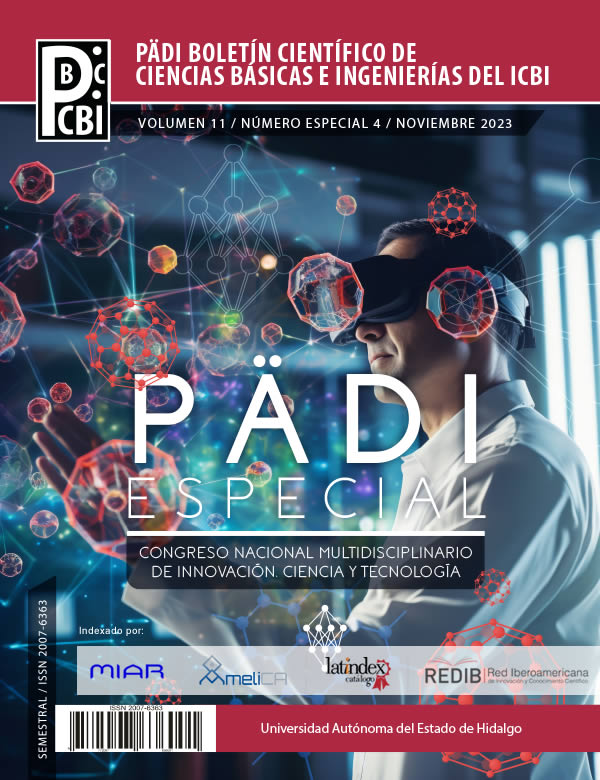Fabrication and characterization of polymeric semiconductors based on Phthalocyanine Green
Abstract
In the present study, organic semiconductor composite films were manufactured, based on polymethylmethacrylate (PMMA) as matrix, and copper phthalocyanine green (CuPc Green) as reinforcement. The films were deposited by the direct injection technique, using Corning glass substrates, silicon-n wafers, and indium tin oxide (ITO) coated glass. The morphology and mechanical properties of the films were studied by atomic force microscopy (AFM). Subsequently, the PMMA-CuPc Green composite films were analyzed in their optical properties by Ultraviolet-visible spectroscopy (UV-vis), in order to obtain the percentage of Transmittance, the Absorbance and, with these parameters, the absorption coefficient, the energy of the photon and, consequently, the optical bandgap. Finally, simple single-layer devices were fabricated, and their electrical properties were evaluated, using the four-prong collinear method. In addition, the devices were subjected to different radiation conditions, to determine the possible application of PMMA-CuPc Green semiconductor films, in optoelectronic devices.
Downloads
References
Abuelwafa, A. A., El-Denglawey, A., Dongol, M., El-Nahass, M. M., & Soga, T. (2015). Influence of annealing temperature on structural and optical properties of nanocrystalline Platinum octaethylporphyrin (PtOEP) thin films. Optical Materials, 49, 271–278. https://doi.org/https://doi.org/10.1016/j.optmat.2015.09.032
Bronstein, H., Nielsen, C. B., Schroeder, B. C., & McCulloch, I. (2020). The role of chemical design in the performance of organic semiconductors. Nature Reviews Chemistry, 4(2), 66–77. https://doi.org/10.1038/s41570-019-0152-9
Chen, F.-C. (2018). Organic Semiconductors. In B. D. Guenther & D. G. Steel (Eds.), Encyclopedia of Modern Optics (Second Edition) (Second Edition, pp. 220–231). Elsevier. https://doi.org/https://doi.org/10.1016/B978-0-12-803581-8.09538-2
Christie, R., & Abel, A. (2021). Phthalocyanine green pigments. 6(11), 665–669. https://doi.org/doi:10.1515/psr-2020-0193
Ding, J., Cui, Z., Dong, N., Li, B., Zhang, Y., Wang, J., & Jiang, Z. (2020). Enhanced optical limiting properties of composite films consisting of hyperbranched phthalocyanine and polyphenylsulfone with high linear transmittance. Synthetic Metals, 265, 116405. https://doi.org/https://doi.org/10.1016/j.synthmet.2020.116405
Dong, H., Zhu, H., Meng, Q., Gong, X., & Hu, W. (2012). Organic photoresponse materials and devices. Chemical Society Reviews, 41(5), 1754–1808. https://doi.org/10.1039/C1CS15205J
El-Nahass, M. M., Ammar, A. H., Farag, A. A. M., Atta, A. A., & El-Zaidia, E. F. M. (2011). Effect of heat treatment on morphological, structural and optical properties of CoMTPP thin films. Solid State Sciences, 13(3), 596–600. https://doi.org/10.1016/j.solidstatesciences.2010.12.032
Farag, A. A. M. (2007). Optical absorption studies of copper phthalocyanine thin films. Optics & Laser Technology, 39(4), 728–732. https://doi.org/https://doi.org/10.1016/j.optlastec.2006.03.011
Fouriaux, S., Armand, F., & Araspin, O. (1996). Effect of the metal on the organization of tetramidometalophthalocyanines in langmuir-blodgett films. J Phys Chem., 16984–16988.
Gohil, S. V, Suhail, S., Rose, J., Vella, T., & Nair, L. S. (2017). Chapter 8 - Polymers and Composites for Orthopedic Applications. In S. Bose & A. Bandyopadhyay (Eds.), Materials for Bone Disorders (pp. 349–403). Academic Press. https://doi.org/https://doi.org/10.1016/B978-0-12-802792-9.00008-2
Hains, A. W., Liang, Z., Woodhouse, M. A., & Gregg, B. A. (2010). Molecular Semiconductors in Organic Photovoltaic Cells. Chemical Reviews, 110(11), 6689–6735. https://doi.org/10.1021/cr9002984
Khambhati, D. P., & Nelson, T. L. (2022). 6 - Semiconductive materials for organic electronics and bioelectronics from renewable resources. In A. Marrocchi (Ed.), Sustainable Strategies in Organic Electronics (pp. 209–227). Woodhead Publishing. https://doi.org/https://doi.org/10.1016/B978-0-12-823147-0.00006-9
Kim, K., Yoo, H., & Lee, E. K. (2022). New Opportunities for Organic Semiconducting Polymers in Biomedical Applications. Polymers, 14(14). https://doi.org/10.3390/polym14142960
Lee, S. U., Kim, J. C., Mizuseki, H., & Kawazoe, Y. (2010). The Origin of the Halogen Effect on the Phthalocyanine Green Pigments. Chemistry – An Asian Journal, 5(6), 1341–1346. https://doi.org/https://doi.org/10.1002/asia.200900601
Li, H., Li, C., Duan, L. and Qiu, Y. (2014), Charge Transport in Amorphous Organic Semiconductors: Effects of Disorder, Carrier Density, Traps, and Scatters. Isr. J. Chem., 54: 918-926. https://doi.org/10.1002/ijch.201400057
Mali, S. S., Dalavi, D. S., Bhosale, P. N., Betty, C. A., Chauhan, A. K., & Patil, P. S. (2012). Electro-optical properties of copper phthalocyanines (CuPc) vacuum deposited thin films. RSC Adv., 2(5), 2100–2104. https://doi.org/10.1039/C2RA00670G
Radhakrishnan, S. y Deshpande, S. (2002). Polímeros conductores funcionalizados con ftalocianina como sensores de dióxido de nitrógeno. Sensores, 2 (5), 185–194. MDPI AG. Obtenido de http://dx.doi.org/10.3390/s20500185
Raghuwanshi, V., & Tiwari, S. P. (2023). Chapter 11 - Flexible electronics and devices with new materials. In A. Sarkar, C. K. Sarkar, A. Deyasi, D. De, & A. Benfdila (Eds.), Nanoelectronics: Physics, Materials and Devices (pp. 237–262). Elsevier. https://doi.org/https://doi.org/10.1016/B978-0-323-91832-9.00004-X
Sakamoto, K., & Ohno-Okumura, E. (2009). Syntheses and Functional Properties of Phthalocyanines. Materials, 2(3), 1127–1179. https://doi.org/10.3390/ma2031127
Sánchez Vergara, ME, Toledo Dircio, E., & Zubillaga Serrano, RI (2022). Deposición y Caracterización de Heteroestructuras Basadas en Ferroceno Dopado para Aplicaciones Film-Device. Recubrimientos, 12 (12), 1859. MDPI AG. Obtenido de http://dx.doi.org/10.3390/coatings12121859
Sánchez-Vergara, M. E., Rios, C., Jiménez-Sandoval, O., & Salcedo, R. (2020). A Comparative Study of the Semiconductor Behavior of Organic Thin Films: TCNQ-Doped Cobalt Phthalocyanine and Cobalt Octaethylporphyrin. Molecules, 25(24). https://doi.org/10.3390/molecules25245800
Serra, O. A., & Iamamoto, Y. (2001). Chromophores: Porphyrin-based Materials. In K. H. J. Buschow, R. W. Cahn, M. C. Flemings, B. Ilschner, E. J. Kramer, S. Mahajan, & P. Veyssière (Eds.), Encyclopedia of Materials: Science and Technology (pp. 1227–1229). Elsevier. https://doi.org/https://doi.org/10.1016/B0-08-043152-6/00231-X
Sigma-Aldrich. (2023). Phthalocyanine Green [Fotografía]. Merck KGaA, Darmstadt, Alemania: Sigma-Aldrich Corp. https://www.sigmaaldrich.com/MX/es/product/aldrich/cds000384
Socol, M., Preda, N., Rasoga, O., Breazu, C., Stavarache, I., Stanculescu, F., Socol, G., Gherendi, F., Grumezescu, V., Popescu-Pelin, G., Girtan, M., & Stefan, N. (2016). Flexible heterostructures based on metal phthalocyanines thin films obtained by MAPLE. Applied Surface Science, 374, 403–410. https://doi.org/10.1016/j.apsusc.2015.10.166
Urbach, F. (1953). The Long-Wavelength Edge of Photographic Sensitivity and of the Electronic Absorption of Solids. Physical Review, 92(5), 1324. https://doi.org/10.1103/PhysRev.92.1324
Vivo, P., Ojala, M., Chukharev, V., Efimov, A., & Lemmetyinen, H. (2009). Role of a phthalocyanine–fullerene dyad in multilayered organic solar cells. Journal of Photochemistry and Photobiology A: Chemistry, 203(2), 125–130. https://doi.org/10.1016/j.jphotochem.2008.12.030
Yoo, S.-J. and Kim, J.-J. (2015), Charge Transport in Electrically Doped Amorphous Organic Semiconductors. Macromol. Rapid Commun., 36: 984-1000. https://doi.org/10.1002/marc.201500026
Zhang, Q., Hu, W., Sirringhaus, H., & Müllen, K. (2022). Recent Progress in Emerging Organic Semiconductors. Advanced Materials, 34(22), 2108701. https://doi.org/https://doi.org/10.1002/adma.202108701
Copyright (c) 2023 Joaquín André Hernández-Méndez, María Elena Sánchez-Vergara

This work is licensed under a Creative Commons Attribution-NonCommercial-NoDerivatives 4.0 International License.













